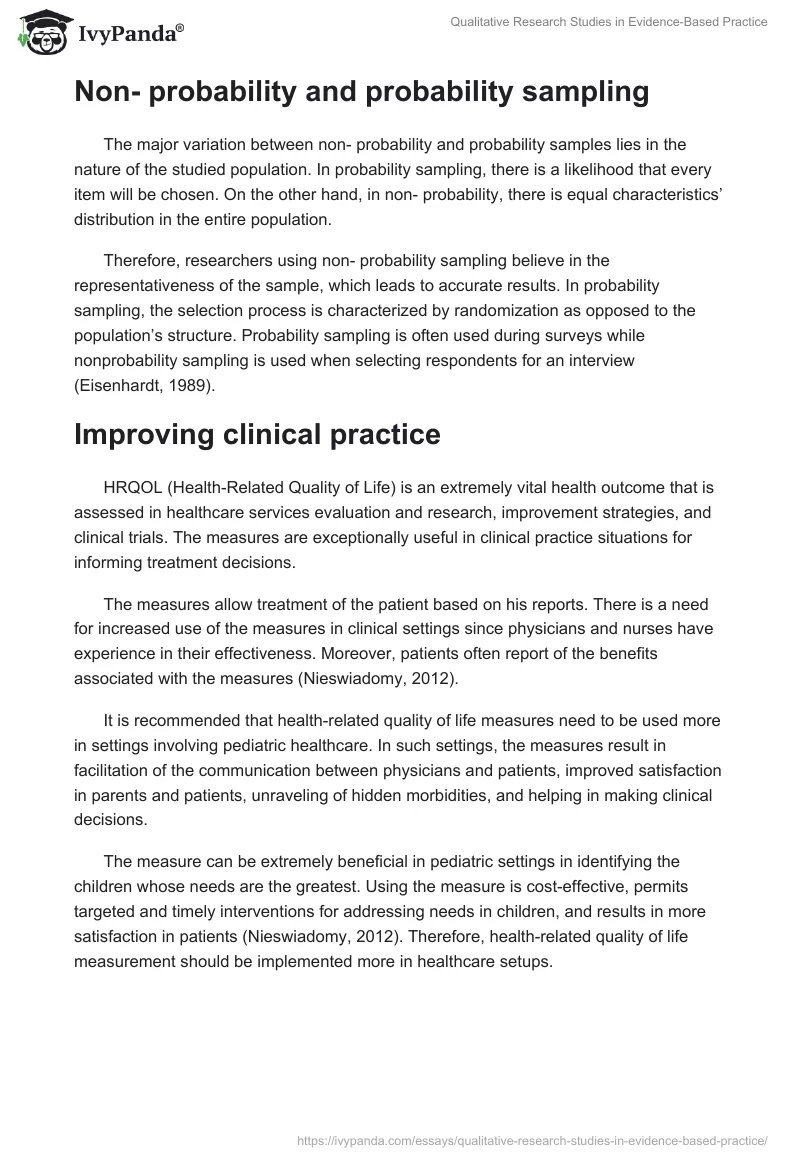Evidence-based practice involves providing quality care to patients, which is associated with better patient results as well as satisfaction. Evidence-based practice entails continuous research in search of novel practices, policies, and interventions that can better patient outcome.
Irrespective of the fact that valuable knowledge and strong evidence emanate from qualitative and quantitative methods of research, qualitative methods are not used commonly in evidence-based practice (Nieswiadomy, 2012).
A majority of the medical scientists consider qualitative research to be anecdotal and unscientific. On the same note, it is worth pointing out that medicine goes beyond the utilization of scientific rules. Commonly, clinical experience is founded on judgment, reflection, and personal observation.
It is necessary for translating scientific results that allows patient treatment. Personal experience is regarded as un- generalizable and anecdotal. Therefore, it forms a poor foundation for deducing scientific decisions (Eisenhardt, 1989).
Experimental and non- experimental research
Presently, qualitative research studies never involve the review of evidence-based practice studies. Non- experimental and experimental researches form the two kinds of quantitative research studies. Experimental research involves research designs that entail controlling and manipulating the testing involved. This assists in comprehending the causal procedures.
It involves manipulating a few variables and consequently identifying the impact on dependent variables. The changes in the dependent variables are measured and controlled. Experimental research is more convenient where time is of the essence in causal relationships, a cause and effect relationship is consistent, and the correlation magnitude is high.
Non- probability and probability sampling
The major variation between non- probability and probability samples lies in the nature of the studied population. In probability sampling, there is a likelihood that every item will be chosen. On the other hand, in non- probability, there is equal characteristics’ distribution in the entire population.
Therefore, researchers using non- probability sampling believe in the representativeness of the sample, which leads to accurate results. In probability sampling, the selection process is characterized by randomization as opposed to the population’s structure. Probability sampling is often used during surveys while nonprobability sampling is used when selecting respondents for an interview (Eisenhardt, 1989).
Improving clinical practice
HRQOL (Health-Related Quality of Life) is an extremely vital health outcome that is assessed in healthcare services evaluation and research, improvement strategies, and clinical trials. The measures are exceptionally useful in clinical practice situations for informing treatment decisions.
The measures allow treatment of the patient based on his reports. There is a need for increased use of the measures in clinical settings since physicians and nurses have experience in their effectiveness. Moreover, patients often report of the benefits associated with the measures (Nieswiadomy, 2012).
It is recommended that health-related quality of life measures need to be used more in settings involving pediatric healthcare. In such settings, the measures result in facilitation of the communication between physicians and patients, improved satisfaction in parents and patients, unraveling of hidden morbidities, and helping in making clinical decisions.
The measure can be extremely beneficial in pediatric settings in identifying the children whose needs are the greatest. Using the measure is cost-effective, permits targeted and timely interventions for addressing needs in children, and results in more satisfaction in patients (Nieswiadomy, 2012). Therefore, health-related quality of life measurement should be implemented more in healthcare setups.
References
Eisenhardt, K. M. (1989). Building theories from case study research. Academy of management review, 1(3), 532-550.
Nieswiadomy, R. M. (2012). Foundations of Nursing Research (6th ed.). New York: Pearson Prentice Hall.


